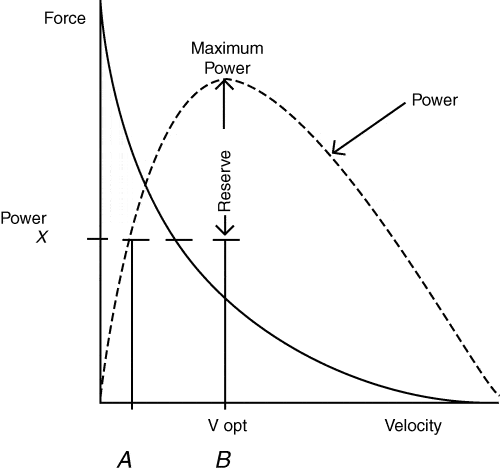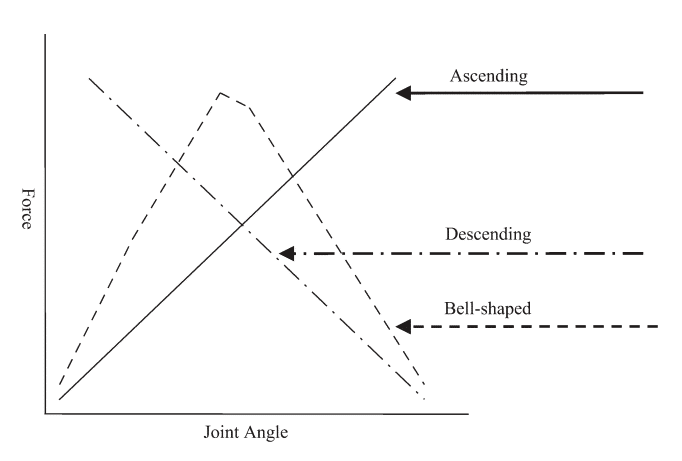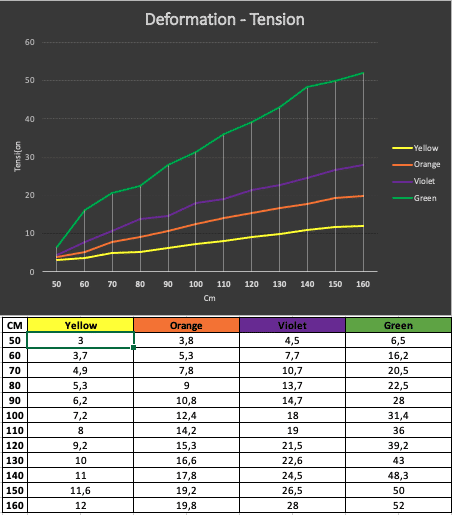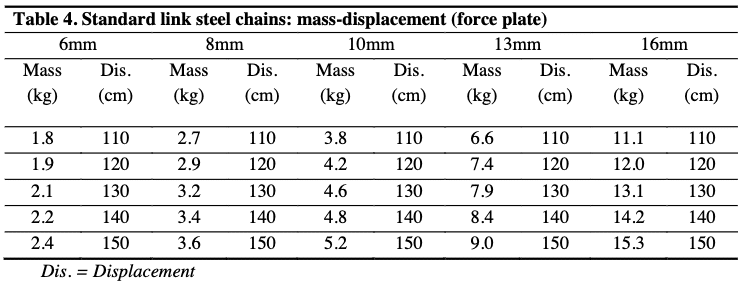20 de January de 2021
Accommodating Resistance Training – Bands and Chains in VBT
Power development is not only a key aspect in most sports activities, but also athletes’ capacity to generate power output is a strong indicator of sports performance. That is why strength coaches and sports scientists are constantly searching for new training methods and techniques that allow athletes to manifest their maximum power. One such method that has recently become popular is Variable Resistance Training (VRT)1.
VRT is a broad term used to describe loading techniques that provide changing loads throughout a movement and traditionally involves an increasing load during the concentric phase and decreasing load during the eccentric phase. The concept of VRT is nothing but new. There is some evidence showing attempts to produce progressive resistance with the help of pulley systems and counterbalances as early as the 1940s. However, during the last decades, VRT has gained a lot of popularity among S&C coaches and athletes due to the fact that variable resistance can also be produced through the use of elastic bands or chains1–3.
But before we dig deeper into this topic, it is important to review some basic concepts about kinetic and kinematics applied to basic strength exercises.
In most resistance exercises (non-ballistic ones), movement starts from zero velocity, achieves peak velocity at some intermediate time within the concentric portion of the lift, and finally, returns again to zero velocity. Thus, a considerable portion of the concentric phase, especially the latter stages of the concentric phase of the movement, is devoted to decelerate the load, especially with light (<50/60%1RM) and medium loads (60-75/80% 1RM)4. This negative acceleration (deceleration) appears to be greater than what would be expected due solely to the effect of gravity and it´s due to the athlete´s force applied in the opposite direction of the motion. As a result, the force applied by the athlete against the external load is negative and from a kinematic point of view the movement can be further subdivided into a ‘ propulsive ’ ( F > 0) and a ‘ braking ’ ( F < 0) phase4. This Differentiation is not merely a division of the concentric phase but appears to be much more relevant than previously thought2,5. Essentially in these situations, the neuromuscular system is being trained to decelerate at the end range, not accelerate, as is required in many sports actions2.

Figure 1 Comparison between bench press performed with 20 vs 80% 1RM. As the load increases, the breaking phase shortens and the accelerating phase increase. Velocity decreases as the time to reach peak velocity increase when load is greater.
Moreover, mechanical power can be defined as the ratio between work and time or the force multiplied by the movement velocity6:
Power=Force x Velocity
Since power is the product of force and speed, both components are needed in the training of muscular power, as they are closely related: when the movement speed increases, the force that the muscles can produce decreases. Therefore, when referring to the maximum power that can be generated in a movement, this is located at a point between the maximum force and speed, which varies depending on the movement performed7,8.

Figure 2 Relationship between force-velocity, force-power and optimal load
Benefits of VRT
So, varying the resistance applied either with the use of bands or chains, is able to modify the entire movement force production. First of all, given that the load is maximal at the endpoint of the movement (i.e. in the squat; in the standing phase), when the band is fully extended (this not applies to chains), it generates an accentuated loading of the eccentric phase though and increases velocity which can also increase the subsequent concentric Rate of Force Development(RFD)10. And second, as the concentric phase takes place, the load increases either in a curvilinear (bands) or linear (chains) manner, allowing the resistance to augment in the biomechanical advantageous positions as the muscle is capable of exerting a greater force. the term “accommodating resistance”, commonly used to refer to bands and chains resistance training, comes from the fact that the weight ‘accommodates’ (getting heavier or lighter) alongside the biomechanics of a given movement (typically, getting heavier as the movement reaches the endpoint)10–12.
Moreover, taking into account the aforementioned kinematic characteristics of most traditional lifts regarding acceleration, the addition of bands or chains basically eliminates the deceleration phase because after the sticking point acceleration must remain positive to move the increasing load provided by the accommodating resistance10,11, mimicking sports-specific movements such as jumps, throws, and ballistic movements which are known to produce a continuing increase in force throughout the concentric phase until the load is released. The increase in load achieved by variable resistance bands or chains is thought to closely match the increase in accumulated muscular force and increased torque about a joint throughout a concentric movement and may allow for a greater period of activation13.
Finally, the human strength curve is influenced by the torque (a measure of how much a force acting on an object causes that object to rotate) about single joints. The human strength curve can be classified into 3 categories: ascending, descending, and bell-shaped13. The shape of the curve is determined by the force angle relationship. An example of exercises influenced by a descending curve where maximum strength is required at the end of the concentric phase are upper body pulling exercises such as the bent-over row, pull-ups, and bench pulls13. Single-joint movements such as bicep curls or triceps extensions are examples of bell-shaped strength curve exercises where maximum strength occurs around the middle of the movement’s range of motion. Exercises such as a squat and deadlift, are examples of an ascending strength curve13.

Figure 3 Three major strength curves: force production versus joint angle13
Training with elastic bands or chains challenges the ascending strength curve by providing a variable load throughout a range of motion with the most resistance experienced at or near full muscular extension where athletes typically exhibit the highest force production. Elastic bands or chains used as a resistive modality compliment the length-tension relationship by requiring progressive recruitment of high-threshold motor units, thus, requiring the highest motor unit recruitment at the most mechanically advantageous position within that movement13.
Bands
Bands are viscoelastic, exhibiting nonlinear or viscous properties in combination with linear elastic properties. During the elastic region, deformation increases in direct proportion to the amount of tension placed on the band. Technically, the tension provided by the band is equal to the stiffness constant (k) multiplied by the deformation (d)13:
Tension = k(stiffness) x d(deformation)
However, there is an easier way to determine the tension of the band for practical purposes or maybe 2. I’m lucky enough to have a force cell, which measures force directly. So, it only takes a second to attach one end of the band to a rack and the other to the force cell and start pulling while measuring the distance which gives you the force generated by the band at a given distance. The other way is a little more “home-made” but just as effective. Attach the band (or the bands) to the rack and to the barbell, weight yourself in with the barbell (and the bands) as if you were going to do a squat, then repeat the procedure but without the bands. Calculate the differences and you will have how many kg represents the tension exerted by the bands.
Furthermore, McMaster, Cronin, and McGuigan published an outstanding paper about this issue which is more than recommended to take a look at12.

Figure 4 Force generated by different bands of different colours at different lengths measured by a force cell. For example, the violet band generates 13,7 kgF when it´s length is 80 cm (unpublished data).
The use of bands during training has been shown to increase strength in recreational athletes by 10–30% over 6- to 12-week training periods. A study by Damush and Damush found an increase in strength during an 8-week band training program which consisted of twice a week full-body training session performing only one set of seven exercises until a level of 4 was reached on the Borg Perceived Exertion Scale in older women14.
Moreover, when bands are added to free weight exercises, such as the squat, deadlift, and bench press, the added tension towards the end of the positive concentric phase has been shown to improved peak force (16%) and peak power (24%)10. However, this is not always the case as the reason behind it is far more complex15. In addition, it has been shown that when loads were equated, there was greater EMG activity during the eccentric contraction and greater peak velocities in squats performed with the addition of bands16.
When combining bands with free weights, it is recommended that RBR comprises 20–35% of the total resistance and free weights comprise the remaining 65– 80%, with a total load of 60% or 80– 85% of the athletes 1-repetition maximum (1RM) to improve peak power and peak force outputs, respectively, for the back squat and possibly other ascending strength curve exercises10,13,17.
Chains
Chains have similar properties with bands given that resistance increases throughout the range of motion; however, one resistance type increases in a linear (chains) and the other in a curvilinear (bands) fashion13. Chains can be added to free weights to vary the loading pattern through manipulating the external resistance and thus the training stimulus. Adding chains to the ends of a barbell has a similar net effect as bands; as the bar moves upward, resistance progressively increases because the chains are lifted off the ground, and as the bar is lowered the resistance decreases18.
To calculate how much weight represents a chain is even easier than with bands. It’s only necessary to know how much does every link weights and add it to the total as it is lifted.

Figure 5 Table showing the relationship between mass and distance for chains of different diameters12.
It has been suggested that optimal strength gains are achieved using 1RM loads of 80–100% composed of a chain resistance of 10–15% of the total load with the remaining 85–90% of the load comprised of free weight resistance19. As for optimal gains in power, a lighter total resistance between 60 to 90 % of the athletes 1RM should be used, with 80–85% of the percentage load coming from free weight resistance and 15–20% from chains; as this changes the kinetics of an exercise allowing for greater acceleration throughout the range of motion19.
Researchers have reported an increase in peak force and net concentric impulse during the deadlift with the addition of chains. However, the authors also observed a decrease in peak barbell velocity, average velocity, peak power, average power, and peak RFD20. Moreover, Coker et al. observed that time of applied force, initial acceleration, and the recruitment and activity of stabilizing and synergist muscles are increased via chain training21
In addition, some practitioners claim that the oscillating chains may promote improved motor control, increased activation and recruitment of stabilizing and synergist muscles, and enhanced neurological adaptation; but these claims are not scientifically supported and may merely be a result of performing free weight resistance18,21.
If you have any questions, don’t hesitate to ask! Leave a comment or contact us here.
Bibliography
1.Ataee, J., Koozehchian, M. S., Kreider, R. B. & Zuo, L. Effectiveness of accommodation and constant resistance training on maximal strength and power in trained athletes. PeerJ 2, e441 (2014).
2.Baker, D. G. & Newton, R. U. Effect of Kinetically Altering a Repetition via the Use of Chain Resistance on Velocity During the Bench Press. Journal of Strength and Conditioning Research 23, 1941–1946 (2009).
3.Soria-Gila, M. A., Chirosa, I. J., Bautista, I. J., Baena, S. & Chirosa, L. J. Effects of Variable Resistance Training on Maximal Strength. Journal of Strength and Conditioning Research 29, 3260–3270 (2015).
4.Sanchez-Medina, L., Perez, C. E. & Gonzalez-Badillo, J. J. Importance of the Propulsive Phase in Strength Assessment. International Journal of Sports Medicine 31, 123–129 (2009).
5.Newton, R. U., Kraemer, W. J., Häkkinen, K., Humphries, B. J. & Murphy, A. J. Kinematics, Kinetics, and Muscle Activation during Explosive Upper Body Movements. Journal of Applied Biomechanics 12, 31–43 (1996).
6.Knudson, D. V. Correcting the Use of the Term ‘Power’ in the Strength and Conditioning Literature. Journal of Strength and Conditioning Research 23, 1902–1908 (2009).
7.Shrier, I. Optimal Loading for Maximal Power Output during Lower-Body Resistance Exercises. Yearbook of Sports Medicine 2008, 81 (2008).
8.Kawamori, N. & Haff, G. G. The Optimal Training Load for the Development of Muscular Power. Journal of Strength and Conditioning Research 18, 675–684 (2004).
9.Sargeant, A. J. Structural and functional determinants of human muscle power. Experimental Physiology 92, 323–331 (2007).
10.Wallace, B. J., Winchester, J. B. & McGuigan, M. R. Effects of Elastic Bands on Force and Power Characteristics During the Back Squat Exercise. The Journal of Strength and Conditioning Research 20, 268 (2006).
11.Stevenson, M. W., Warpeha, J. M., Dietz, C. C., Giveans, R. M. & Erdman, A. G. Acute Effects of Elastic Bands During the Free-weight Barbell Back Squat Exercise on Velocity, Power, and Force Production. Journal of Strength and Conditioning Research 24, 2944–2954 (2010).
12.Mcmaster, D. T., Cronin, J. & McGuigan, M. R. Quantification of Rubber and Chain-Based Resistance Modes. Journal of Strength and Conditioning Research 24, 2056–2064 (2010).
13.McMaster, D. T., Cronin, J. & McGuigan, M. Forms of Variable Resistance Training. Strength and Conditioning Journal 31, 50–64 (2009).
14.Damush, T. M. & Damush, J. G. The Effects of Strength Training on Strength and Health-Related Quality of Life in Older Adult Women. The Gerontologist 39, 705–710 (1999).
15.Effects of Variable Resistance Training on Maximal Strength. Journal of Strength and Conditioning Research 32, e56 (2018).
16.CRONIN, J., McNAIR, P. & MARSHALL, R. The effects of bungy weight training on muscle function and functional performance. Journal of Sports Sciences 21, 59–71 (2003).
17.WALLACE, B. J., WINCHESTER, J. B. & MCGUIGAN, M. R. EFFECTS OF ELASTIC BANDS ON FORCE AND POWER CHARACTERISTICS DURING THE BACK SQUAT EXERCISE. Journal of Strength and Conditioning Research 20, 268–272 (2006).
18.Berning, J. M., Coker, C. A. & Adams, K. J. Using Chains for Strength and Conditioning. Strength and Conditioning Journal 26, 80–84 (2004).
19.Baker, D. & Newton, R. U. Methods to Increase the Effectiveness of Maximal Power Training for the Upper Body. Strength and Conditioning Journal 27, 24–32 (2005).
20.Swinton, P. A., Stewart, A. D., Keogh, J. W., Agouris, I. & Lloyd, R. Kinematic and Kinetic Analysis of Maximal Velocity Deadlifts Performed With and Without the Inclusion of Chain Resistance. Journal of Strength and Conditioning Research 25, 3163–3174 (2011).
21.Coker, C. A., Berning, J. M. & Briggs, D. L. A Preliminary Investigation of the Biomechanical and Perceptual Influence of Chain Resistance on the Performance of the Snatch. The Journal of Strength and Conditioning Research 20, 887 (2006).

